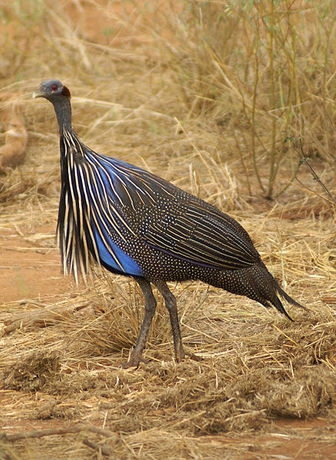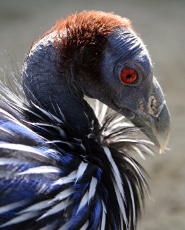Vulturine Guineafowl
It breeds in dry and open habitats with scattered bushes and trees, such as savannah or grassland. It lays its usually 4-8 cream-coloured eggs in a well-hidden grass-lined scrape.

Original source: vulturine guinea fowl Tsavo East feb 2007Uploaded by Snowmanradio
Author: putneymarkCamera location
Vulturine Guineafowl - Poor Flyers, Excellent Runners
 The Vulturine Guinea fowl (Acryllium vulturinum), also known as the Royal Guinea fowl, is the largest species of non-extinct guinea fowls. They range in length from 50.8 to 52.8 centimeters or 20 to 24 inches. In weight, they can vary although there is no data indicating what these ranges may be.
The Vulturine Guinea fowl (Acryllium vulturinum), also known as the Royal Guinea fowl, is the largest species of non-extinct guinea fowls. They range in length from 50.8 to 52.8 centimeters or 20 to 24 inches. In weight, they can vary although there is no data indicating what these ranges may be.
The animal is mostly found in areas of eastern Africa particularly in the tropical regions of Ethiopia, Tanzania, Uganda, Kenya, and Somalia. It is located primarily in areas of dry tall grass with sparse trees. The animals are primarily found in high areas as they prefer to roost out of reach of predators. The animals feed predominantly on seeds, tubers, roots, small reptiles, grubs, as well as small invertebrates, vegetables, and fruits. Their predators are mostly hawks and they escape these, unlike most birds, by running quite well through the brush.
The animal gets its name from its vulture like features, mainly its long neck and small head which are both devoid of feathers. The breast of the bird is a bright cobalt blue with the rest of the body being predominantly black and splattered with white. The females do not differ significantly in appearance from the males although they are typically somewhat smaller than their male counterparts. The bird usually reaches sexual maturity at the age of 2 and has an average lifespan of 15 years. The vulturine guinea fowl (acryllium vulturinum) is currently not on the list of endangered species.
There are several unique characteristics of the vulturine guinea fowl including, for one, their ability to run at great avian speeds. In fact, they rarely have the need to fly except when flying to their nocturnal roosts. Another interesting aspect of the animal is that the sexes are practically indistinguishable from each other as they both have the same physical characteristics as well as coloring. The guinea fowl is also able to reproduce extensively with hens laying up to 40 eggs per season with the shells of the eggs being quite thick and difficult to damage. In some cases, multiple vulturine guinea fowl hens share the same roosting nest. When the birds are hatched from the eggs, they are almost fully developed and are able to fly within only a few days of birth. The animals tend to be very aggressive and will attack each other should they be competing for food or roost areas in trees.
Picture of the Vulturine Guineafowl, by Manfred Werner, licensed under GFDL
The Vulturine Guineafowl is classified as Least Concern. Does not qualify for a more at risk category. Widespread and abundant taxa are included in this category.

Original source: Drew Avery
Author: Drew Avery
Permission: Some rights reserved
Family : Numididae
Genus : Acryllium
Species : vulturinum
Authority : (Hardwicke, 1834)
